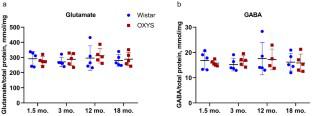Biochemistry (Moscow) ( IF 2.8 ) Pub Date : 2023-12-27 , DOI: 10.1134/s0006297923120027 Alena O. Burnyasheva , Natalia A. Stefanova , Nataliya G. Kolosova , Darya V. Telegina

|
Abstract
GABA and glutamate are the most abundant neurotransmitters in the CNS and play a pivotal part in synaptic stability/plasticity. Glutamate and GABA homeostasis is important for healthy aging and reducing the risk of various neurological diseases, while long-term imbalance can contribute to the development of neurodegenerative disorders, including Alzheimer’s disease (AD). Normalization of the homeostasis has been discussed as a promising strategy for prevention and/or treatment of AD, however, data on the changes in the GABAergic and glutamatergic systems with age, as well as on the dynamics of AD development, are limited. It is not clear whether imbalance of the excitatory/inhibitory systems is the cause or the consequence of the disease development. Here we analyzed the age-related alterations of the levels of glutamate, GABA, as well as enzymes that synthesize them (glutaminase, glutamine synthetase, GABA-T, and GAD67), transporters (GLAST, GLT-1, and GAT1), and relevant receptors (GluA1, NMDAR1, NMDA2B, and GABAAr1) in the whole hippocampus of the Wistar rats and of the senescence-accelerated OXYS rats, a model of the most common (> 95%) sporadic AD. Our results suggest that there is a decline in glutamate and GABA signaling with age in hippocampus of the both rat strains. However, we have not identified significant changes or compensatory enhancements in this system in the hippocampus of OXYS rats during the development of neurodegenerative processes that are characteristic of AD.
中文翻译:

大鼠海马谷氨酸/GABA 系统随年龄的变化以及阿尔茨海默病症状发展过程中的变化
摘要
GABA 和谷氨酸是中枢神经系统中最丰富的神经递质,在突触稳定性/可塑性中发挥着关键作用。谷氨酸和 GABA 稳态对于健康衰老和降低各种神经系统疾病的风险非常重要,而长期失衡可能会导致神经退行性疾病的发展,包括阿尔茨海默病 (AD)。体内平衡正常化被认为是预防和/或治疗 AD 的一种有前景的策略,然而,有关 GABA 能和谷氨酸能系统随年龄变化以及 AD 发展动态的数据有限。目前尚不清楚兴奋/抑制系统的失衡是疾病发展的原因还是结果。在这里,我们分析了谷氨酸、GABA 以及合成它们的酶(谷氨酰胺酶、谷氨酰胺合成酶、GABA-T 和 GAD67)、转运蛋白(GLAST、GLT-1 和 GAT1)和Wistar 大鼠和加速衰老 OXYS 大鼠(最常见(> 95%)散发性 AD 模型)整个海马中的相关受体(GluA1、NMDAR1、NMDA2B 和 GABAAr1)。我们的结果表明,两种大鼠品系的海马中谷氨酸和 GABA 信号随着年龄的增长而下降。然而,在 AD 特征性神经退行性过程的发展过程中,我们尚未发现 OXYS 大鼠海马中该系统的显着变化或代偿性增强。



























 京公网安备 11010802027423号
京公网安备 11010802027423号